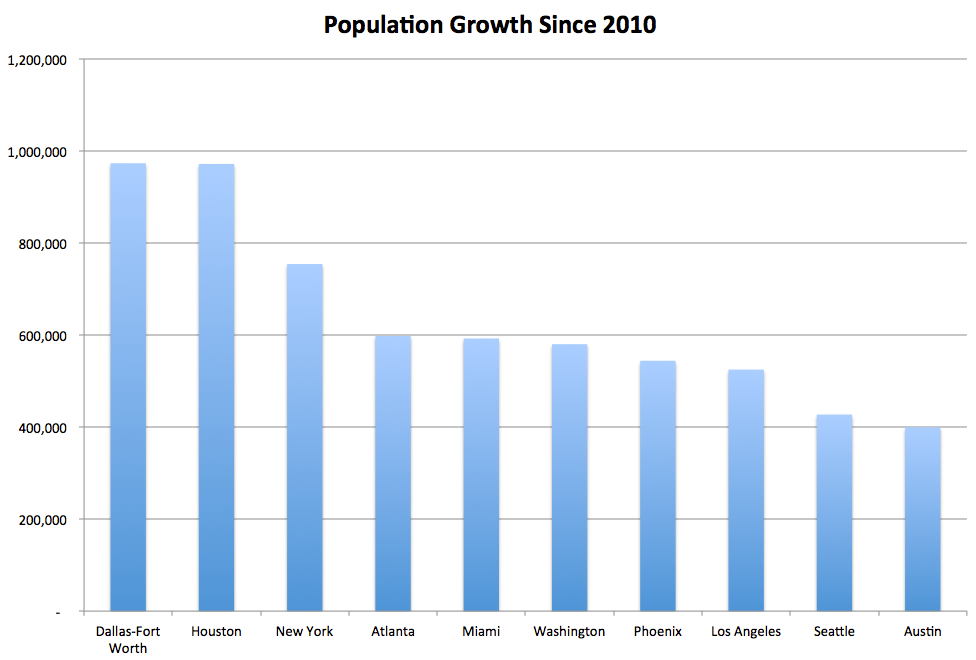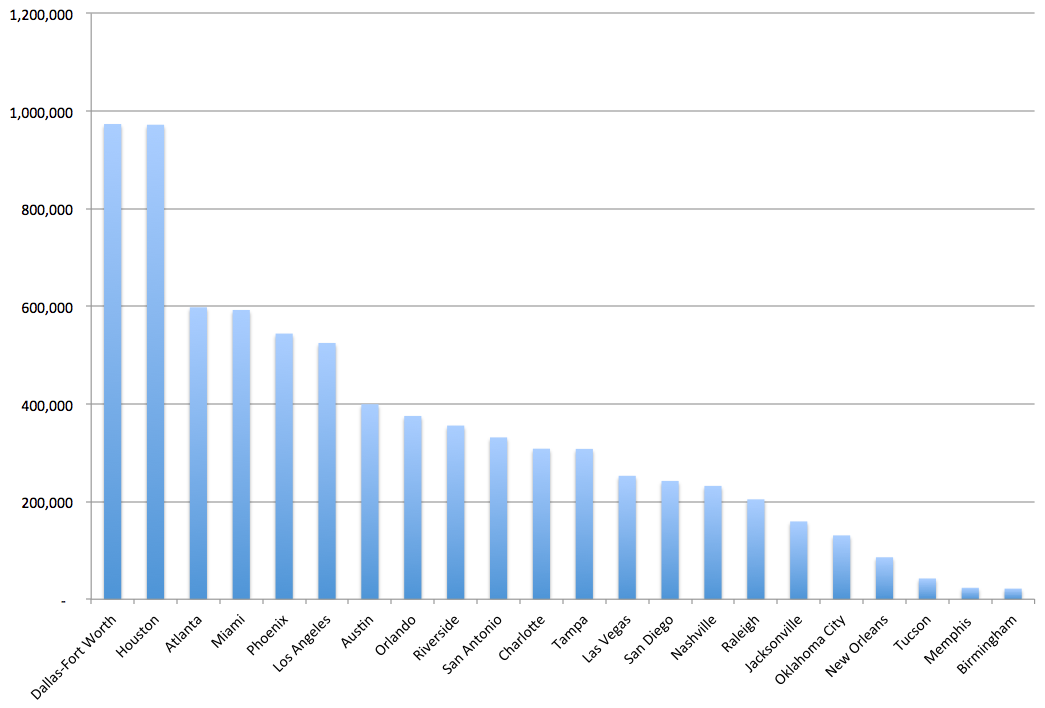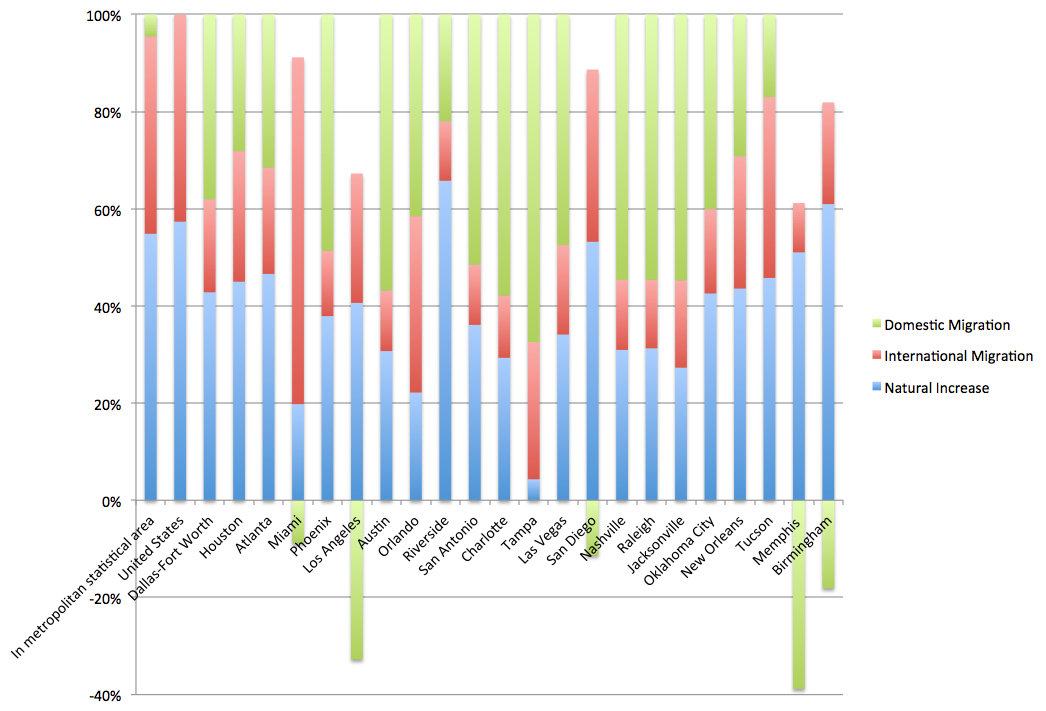The big Census news this week was that Dallas buried Houston in population growth between 2016 and 2017 – a pretty significant change from the past few years, when the two metro areas have run neck-and-neck.
Metro Houston still grew a lot, to be sure, adding almost 100,000 people, good for second place in the population derby. But in previous years, both Dallas and Houston had added somewhere in the ballpark of 150,000 people per year, so that’s a significant drop for Houston. And since these population figures were estimates as of July 1, 2017, nobody yet knows whether Houston will take more of a population hit because of Hurricane Harvey.
But over time, a couple of bigger trends are holding.
First and maybe most important, since 2010 Dallas and Houston have lapped everybody else in the country in terms of population growth. Each metro has added almost 1 million residents in seven years (actually 973,000 for Dallas and 971,000 for Houston). Only New York – which has added around 700,000 residents but has a much bigger population to begin with – is close. Everybody else is far behind.


But the second trend may be equally important: Large Sun Belt metros continue to drive the nation’s population growth. There are 22 metros in the Sun Belt (as defined by the Kinder Institute) with a population of 1 million people or more. And no matter which metro area is first, these metros have consistently accounted for almost half of all American population growth over the past few years.
Here are the numbers: Since 2010, the United States population – including population in almost 300 metropolitan areas and the rest of the country as well – has increased by about 17.1 million people. The 22 large Sun Belt have grown by about 7.7 million all by themselves, meaning the entire rest of the country added less than 10 million.
And, just to put this in a little more perspective, the four large Texas metros alone – Dallas, Houston, Austin, and San Antonio – grew by a total of 2.7 million people, which accounts for 16 percent of national population growth.
A breakdown of these 22 metro areas is revealing. As stated previously, Dallas and Houston lead the pack, with an increase of about 1 million each. Then come Atlanta, Miami, Los Angeles, and Phoenix, each with somewhere around 500,000 each. At the other end of the spectrum in the Sun Belt are three slow-growing cities that are often viewed as the Sun Belt’s “Rust Belt” – Memphis, Birmingham, and New Orleans – as well as Tucson, whose metro population topped 1 million people just in the last couple of years.

The components of population growth in each of these 22 metro areas is revealing as well, because they show how different even Sun Belt cities are. Miami, San Diego, and Los Angeles are still growing overall, but that’s largely because of international immigration (especially Miami) and “natural increase,” which means births over deaths.
These three large metros are actually losing residents to other locations in the United States, but more than making up for it by natural increase and international immigration.

Meanwhile, several other metro areas – especially in the South – are growing in population in large part because they are gaining residents from other locations in the United States. Hot cities such as Austin, Charlotte, Nashville, Raleigh, and Jacksonville all get more than half of their population growth from this domestic in-migration. (It’s interesting to note that Austin and Nashville are among the hottest real estate markets in the country not located on the coasts.) Interestingly, Atlanta – often viewed anecdotally as a major destination for domestic in-migration – is well behind these other metro areas and gets more population growth from natural increase than domestic in-migration.
Meanwhile, Dallas – and especially Houston – are growing in a pretty balanced way, with major components of population growth coming from natural increase, international immigration, and domestic in-migration.
Indeed, Houston – in keeping with Kinder Institute Founding Director Stephen Klineberg’s characterization of the city as a prophetic harbinger of things to come in the United States – is about as even in its population growth as any Sun Belt city: 45 percent natural increase, 27 percent international immigration, and 28 percent domestic in-migration. Harvey could change that, of course. International immigration might slow down, and the domestic in-migration number could go down, if more people leave and fewer arrive from elsewhere in the U.S. because of the city’s reputation as flood-prone. But we’ll have to wait until next year’s Census estimates to find out.

